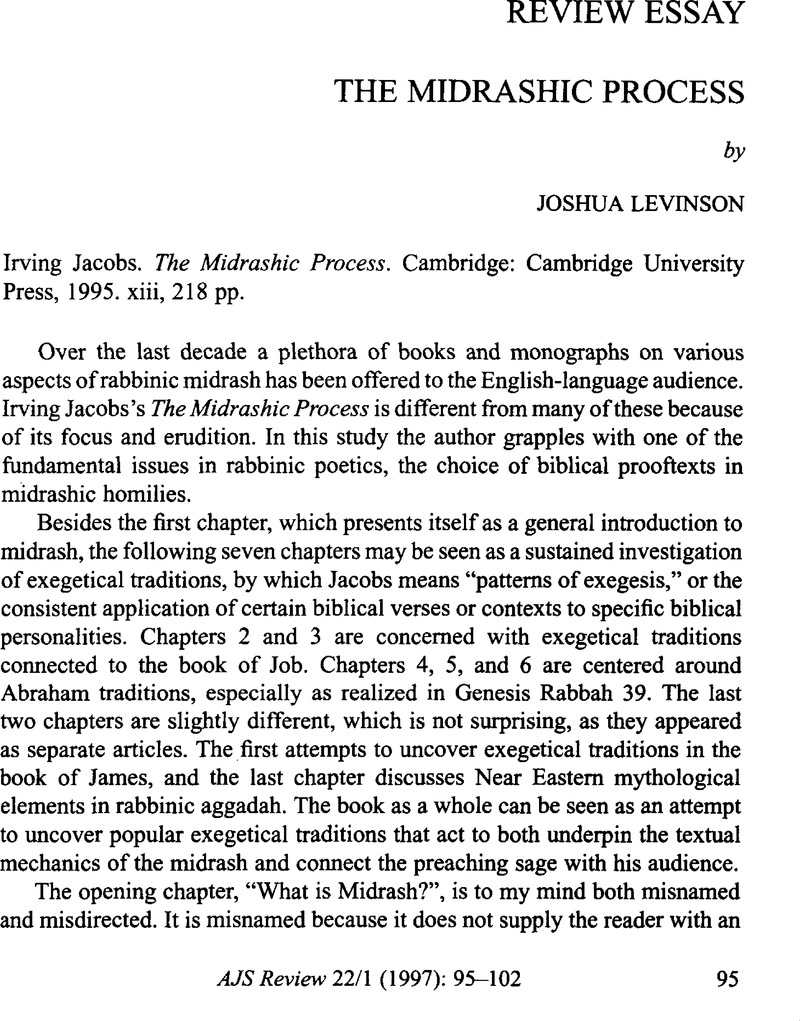No CrossRef data available.
Article contents
The Midrashic Process
Published online by Cambridge University Press: 15 October 2009
Abstract

- Type
- Review Essays
- Information
- Copyright
- Copyright © Association for Jewish Studies 1997
References
1. Steven, Fraade, From Tradition to Commentary (Albany: State University of New York; Press, 1991), p. 14.Google Scholar
2. Daniel, Boyarin, Intertextuality and the Reading of Midrash (Bloomington: Indiana; University Press, 1990).Google Scholar
3. James, Kugel, In Potiphar′s House, (New York: HarperCollins, 1990).:Google Scholar
4. In all fairness, Jacobs does recount in this chapter the well-known positions on “plain meaning,” citing mostly Loewe and Weiss-Halivni, but the import of this controversy for the rest of the book is unclear.
5. E.g., see Avigdor, Shinan, “LeTorat HaPetihta,” Jerusalem Studies in Hebrew Literature 1 (1981): 133–143Google Scholar; Richard, Sarason, “The Petihtot in Leviticus Rabbah: ‘Oral Homilies’ or Redactional Constructions?”, Journal of Jewish Studies 33 (1982): 557–567Google Scholar; Martin, Jaffee, “The Midrashic Proem: Towards the Description of Rabbinic Exegesis,” Approaches to Ancient Judaism 4 (1983): 95112Google Scholar; Avigdor, Shinan, “Sermons, Targums, and the Reading from Scriptures in the Ancient Synagogue,” in The Synagogue in Late Antiquity, ed. Levine, L. I., (Philadelphia: American Schools of Oriental Research, 1987), pp. 97–110Google Scholar; Yona, Fraenkel, Darkhei HaAgaddah VeHamidrash, (Givataiim: Yad LeTalmud, 1991), pp. 443–452.Google Scholar
6. There are some minor objections which should be mentioned here. For some reason Jacobs refers to the amoraic midrashic collections Genesis Rabbah and Leviticus Rabbah as “post-talmudic” (pp. 2,16). Likewise, he refers to Exodus Rabbah I as a collection of similar age as Genesis Rabbah (p. 7), instead of the accepted dating of this collection to the tenth-eleventh centuries. Shinan, A., Midrash Shemot Rabbah (Jerusalem: Dvir, 1984), p. 23.Google Scholar
7. , Kugel, In Potiphar′s House, p. 266.Google Scholar
8. This historical obfiiscation does not help his argument. Likewise he uses the term “great intiquity” a number of times without informing the reader about which period he is concerned.; rom further discussions it would seem that he is referring to prebiblical traditions (p. 168), nit he is never precise on this crucial Doint.
9. Marc, Hirshman, “On the Forms and the Methods of Midrash,” Jewish Studies: Forum of the World Union of Jewish Studies 32 (1992): 83–90.Google Scholar
10. Genesis Rabbah 34:5, 315.
11. Tanhuma, Buber, Miketz 7.
12. Tanhuma waYigash 4.
13. Mekhilta Beshallah 1,78.
14. Likewise, the proem based on Song of Songs 8:8 to which he devotes chapter 6 appears in Song of Songs Rabbah not as a proem at all but as a petira. It is not clear if this change in genre affects his argument.
15. See Bernard, Heller, “Egyptian Elements in the Haggadah,” in Ignace Goldziher Memorial Volume, vol. 1, ed. S., Lowinger and J., Somogyi (Budapest: Globus, 1948), pp. 412–418Google Scholar; Louis, Ginzberg, On Jewish Law and Lore (New York: Atheneum, 1955), pp. 62–63Google Scholar. Neither of these two classical studies is cited by Jacobs. For more recent discussions, also uncited, see Boyarin, Intertextuality, p. 93; and Michael, Fishbane, “The Holy One Sits and Roars: Mythopoesis and the Midrashic Imagination,” in The Midrashic Imagination, ed. M., Fishbane (Albany: State University of New York Press, 1993), pp. 60–77.Google Scholar
16. BT Bava Batra 74b.
17. See Urbach, E. E., The Sages (Jerusalem: Magnes Press, 1975), p. 137.Google Scholar
18. Samuel, Sandmel, “Parallelomania,” Journal of Biblical Literature 81, no. 1 (1962):Google Scholar
19. Genesis Rabbah 5:2, 33 uses the verb JIT, as Jacobs himself notes (p. 157, n. 15)? Interesting enough, this early rabbinic text uses the image of inflated skin bottles to describe God′s conflict with the sea. As Tur–Sinai, N. H. showed in The Book of Job (Jerusalem: Kiryat Sepher, 1957), p. 383Google Scholar, this image (a bag or net) appears in Job 26:13 and the Akkadian Enuma Elish. See also Edward, Greenstein, “The Snaring of Sea in the Baal Epic,” Maarav 3 (1983): 195–216.Google Scholar




